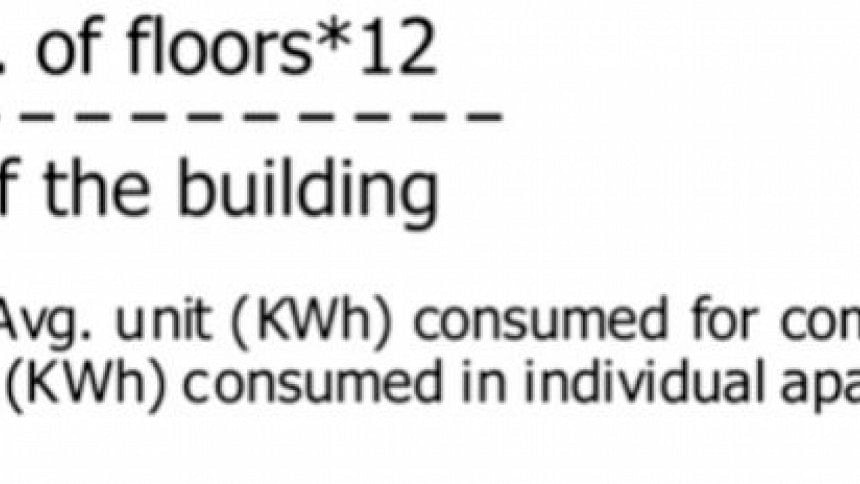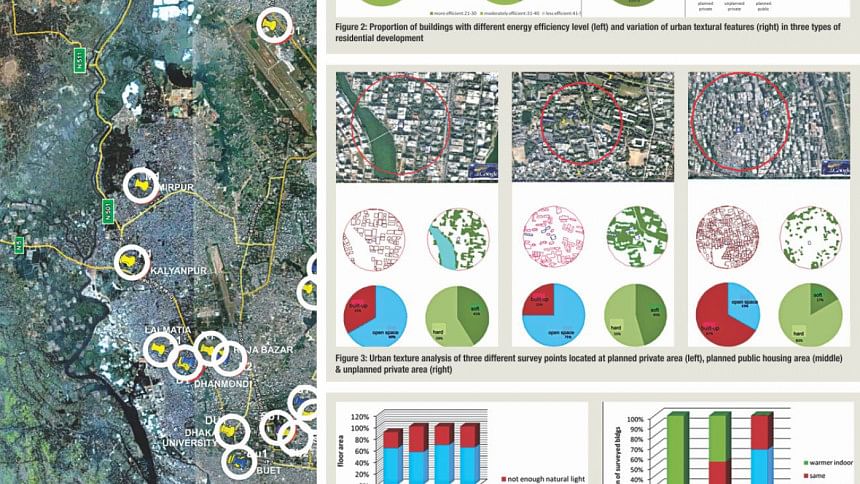Energy consumption and urban texture: A case study of Dhaka

Energy is a burning issue for the twenty-first century Bangladesh. With the ever growing demand for energy to cope with a developing economy on one hand and the impact of climate change on the natural environment on the other, ensuring adequate supply of energy and its efficient use has become the key factor for sustainable development. With only 43% electricity coverage country wide, the capital city of Dhaka consumes almost 55% of total generated electricity, the largest share of which is claimed by its domestic sector according to the Dhaka Power Distribution Company Limited (DPDC). Land scarcity and high demand of housing units in this city led to a development trend characterised by high-density building blocks without the provision of open space and greenery. These buildings are deprived of natural ventilation and lighting provisions and suffer from urban heat island (UHI) effect resulting in higher dependency on artificial lighting and air conditioning.
In this context, a survey was done on Dhaka City's residential apartment buildings located in areas which vary in density and provision of open space and vegetation. The research (Ahmed, 2010) was about the existing energy end-use trend of Dhaka City's residential apartment buildings and its correlation with urban texture and the ambient environment. The rest of this article will present the key findings of that research in terms of 'building energy efficiency' and 'urban texture'.

The quantitative definition of 'building energy efficiency' is the amount of energy in the form of electricity consumed per unit area for a specific time period in a building by its users expressed in KWh/m²/year, while, the qualitative aspect of energy efficiency of buildings involves reduced energy consumption for acceptable levels of comfort, air quality and other occupancy requirements. The term 'urban texture' relates to urban geometry, urban form and also the surface quality of urban areas which have impact on the urban micro climate therefore have strong relationship with energy consumption in urban buildings.
30 residential apartment buildings were taken as case studies from 11 different residential areas of Dhaka City Corporation area. Based on type of development, these residential areas can be classified under three categories: planned private development, un-planned private development and planned public housing. About 11 of the case study buildings are apartments with lifts and the rest 19 buildings are walk-up apartments. Data regarding the electricity consumption of the households, amount of naturally lit indoor spaces and ambient thermal condition inside the apartments and around the buildings, ratio of open space to built-up spaces in the area and ratio of green and water-body to hard surfaces were analysed to derive a base line scenario of energy consumption in apartment buildings and correlation with the selected parameters of the corresponding urban texture. The calculation of energy efficiency of a particular building has been done by using the following formula;
The estimated building energy efficiency (EE) of the surveyed residential apartment buildings in the case study areas ranges from as low as 21 KWh/m²/yr. to as high as 49.8 KWh/m²/yr. The distribution of 'more efficient', 'moderately efficient' and 'less efficient' buildings and the textural variation in different types of developments is presented in figure 2.
Data Source: Survey done by researcher from August 2009 till November 2009
Table 1 show the corresponding average values of the parameters for both low consuming i.e. apparently 'more efficient' and high consuming i.e. apparently 'less efficient' buildings. It is evident from the table that better efficiency of a building corresponds to;
* larger amount of open space in the surrounding area
* greater provision of green and water bodies
* cooler indoor thermal conditions in warmer seasons
* linearity of the shape of floor plate
* higher ratio of distance to height of adjacent buildings and
* greater access of natural light into the indoor spaces.
The study findings revealed that different types of residential developments vary in urban textural quality and there is substantial variation in 'energy efficiency' of buildings in these locations. The findings regarding the impact of physical and environmental characteristics of immediate surroundings of a residential building shows that energy efficiency of a residential apartment building can be positively affected by, greater provision of green, water bodies and open space in the surrounding area, linearity of the shape of floor plate, higher ratio of distance to height of adjacent buildings and higher access of natural light into the indoor spaces. Therefore, land-use planning for future residential areas in Dhaka city should conform to proper guidelines of providing these elements. Increased awareness and incentives to use efficient technology is also vital to improved energy efficiency as higher affordability and ignorance can lead to misuse of energy.
Energy efficiency improvements in residential buildings have large potential for energy conservation. Proper policy measures could enable the residential building sector to function more efficiently, which would ultimately ensure sustainable urban environment.

Md Tarek Haider is Assistant Professor, Dept of Architecture, BUET and Moushumi Ahmed is Assistant Professor, Dept of Architecture, Bangladesh University (BU) Dhaka.

 For all latest news, follow The Daily Star's Google News channel.
For all latest news, follow The Daily Star's Google News channel. 



Comments